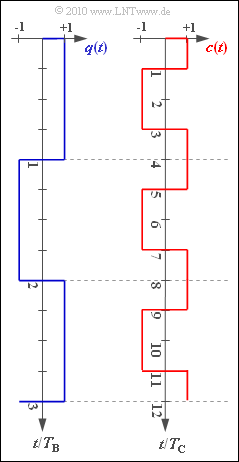Difference between revisions of "Aufgaben:Exercise 3.7Z: Spread Spectrum in UMTS"
From LNTwww
| Line 34: | Line 34: | ||
{Which of the following statements are true? | {Which of the following statements are true? | ||
|type="[]"} | |type="[]"} | ||
| − | - | + | - For UMTS the bit duration $T_{\rm B}$ is fixed. |
| − | + | + | + For UMTS, the chip duration $T_{\rm C}$ is fixed. |
| − | - | + | - Both values depend on the channel conditions. |
| − | { | + | {Specify the chip duration $T_{\rm C}$ and the chip rate $R_{\rm C}$ in the downlink. |
|type="{}"} | |type="{}"} | ||
$R_{\rm C} \ = \ $ { 3.84 3% } $\ \rm Mchip/s $ | $R_{\rm C} \ = \ $ { 3.84 3% } $\ \rm Mchip/s $ | ||
$T_{\rm C} \hspace{0.18cm} = \ $ { 0.26 3% } $ \ \rm µ s $ | $T_{\rm C} \hspace{0.18cm} = \ $ { 0.26 3% } $ \ \rm µ s $ | ||
| − | { | + | {Which spreading factor can be read from the graph on the data page? |
|type="{}"} | |type="{}"} | ||
$J \ = \ $ { 4 } | $J \ = \ $ { 4 } | ||
| − | { | + | {What is the bit rate with this spreading factor? |
|type="{}"} | |type="{}"} | ||
$R_{\rm B} \ = \ $ { 960 3% } $\ \rm kbit/s $ | $R_{\rm B} \ = \ $ { 960 3% } $\ \rm kbit/s $ | ||
| − | { | + | {What values do the „chips” of the transmit signal have? |
|type="{}"} | |type="{}"} | ||
$s_{3} \ = \ $ { -1.03--0.97 } | $s_{3} \ = \ $ { -1.03--0.97 } | ||
Revision as of 22:17, 7 July 2020
For UMTS/CDMA, the so-called PN modulation is applied:
- The rectangular digital signal $q(t)$ is multiplied by the spread signal $c(t)$ and gives the transmit signal $s(t)$.
- This is by the spreading factor $J$ higher frequent (=more frequent) than $q(t)$; this is called band spreading.
At the receiver the same spreading signal $c(t)$ is added (namely in phase!). This reverses the band spreading ⇒ band compression
The diagram shows exemplary signal characteristics of $q(t)$ und $c(t)$.
Notes:
- This exercise belongs to the chapter Die Charakteristika von UMTS.
- Reference is made to the chapter Nachrichtentechnische Aspekte von UMTS in the book„Beispiele von Nachrichtensystemen”.
- For the calculation of the chip duration $T_{\rm C}$ , please refer to page Physikalische Kanäle .
- There you will find, among other things, the information important for this task, which is transmitted on the so-called Dedicated Physical Channel (DPCH) in ten milliseconds exactly $15 \cdot 2560 \ \rm Chips$ .
- In subtask (5), the system asks for transmit chips. For example, the "sending chip" $s_{3}$ denotes the constant signal value of $s(t)$ in the time interval $2T_{\rm C}$ ... $3T_{\rm C}$.
Questionnaire
Musterlösung
(1) Richtig ist der Lösungsvorschlag 2:
- Fest vorgegeben ist bei UMTS die Chipdauer $T_{\rm C}$, die in der Teilaufgabe (2) noch berechnet werden soll.
- Je größer der Spreizgrad $J$ ist, desto größer ist die Bitdauer.
(2) Laut dem Hinweis auf der Angabenseite werden in $10 \ \rm ms$ genau $15 \cdot 2560 = 38400 \ \rm Chips$ übertragen.
- Damit beträgt die Chiprate $R_{\rm C} = 100 \cdot 38400 \ {\rm Chips/s} \ \underline{= 3.84 \ \rm Mchip/s}$.
- Die Chipdauer ist der Kehrwert hierzu: $T_{\rm C} \ \underline{\approx 0.26 \ \rm µ s}$.
(3) Jedes Datenbit besteht aus vier Spreizchips ⇒ $\underline{J = 4}$.
(4) Die Bitrate ergibt sich mit dem Spreizfaktor $J = 4$ zu $R_{\rm B} = R_{\rm C}/J \ \underline{= 960 \ \rm kbit/s}$.
- Mit dem für UMTS maximalen Spreizfaktor $J = 512$ beträgt die Bitrate dagegen nur $7.5 \ \rm kbit/s$.
(5) Für das Sendesignal gilt $s(t) = q(t) \cdot c(t)$.
- Die Chips $s_{3}$ und $s_{4}$ des Sendesignals gehören zum ersten Datenbit ($q_{1} = +1)$:
- $$s_3 = c_3 \hspace{0.15cm}\underline {= -1},\hspace{0.4cm}s_4 = c_4 \hspace{0.15cm}\underline {= +1}\hspace{0.05cm}.$$
- Dagegen sind die beiden weiteren gesuchten Sendechips dem zweiten Datenbit $(q_{2} = -1)$ zuzuordnen:
- $$s_5 = -c_5= -c_1 \hspace{0.15cm}\underline {= -1},\hspace{0.4cm}s_6 = -c_6= -c_2 \hspace{0.15cm}\underline {= +1}\hspace{0.05cm}$$
